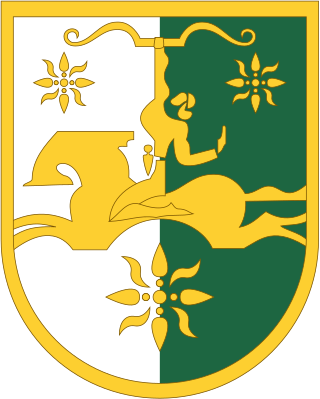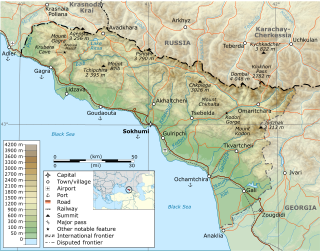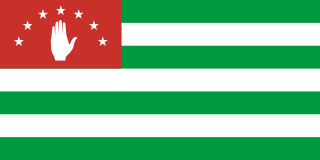
Politics in Abkhazia is dominated by its conflict with Georgia. Abkhazia became de facto independent from Georgia after the 1992–1993 war, but its de jure independence has only been recognised by a few other countries. Abkhazia is a presidential representative democratic republic with a multi-party system, wherein the President is both head of state and head of government. Executive power is exercised by the government of the Republic of Abkhazia. Legislative power is vested in both the government and the People's Assembly of Abkhazia.

The Abkhazia conflict is a territorial dispute over Abkhazia, a region on the eastern coast of the Black Sea in the South Caucasus, at the intersection of Eastern Europe and Western Asia. The conflict involves Georgia, Russian Federation and Russian-backed self-proclaimed Republic of Abkhazia, internationally recognised only by Russia, Venezuela, Nicaragua, Nauru, and Syria; Georgia and all other United Nations members consider Abkhazia a sovereign territory of Georgia. However, as of 2023, Georgia lacks de facto control over the territory.

Zhiuli Shartava was a Georgian politician who served as the Head of the Government of the Autonomous Republic of Abkhazia and was killed by Abkhaz militants during the ethnic cleansing of Georgians in Abkhazia in 1993.

The ethnic cleansing of Georgians in Abkhazia, also known in Georgia as the genocide of Georgians in Abkhazia, refers to the ethnic cleansing, massacres, and forced mass expulsion of thousands of ethnic Georgians living in Abkhazia during the Georgian-Abkhaz conflict of 1992–1993 and 1998 at the hands of Abkhaz separatists and their allies. Armenians, Greeks, Russians, and opposing Abkhazians were also killed.

Guram Gabiskiria was an Abkhaz politician who served as mayor of Sukhumi. He was murdered by separatists during the ethnic cleansing of Georgians in Abkhazia in 1993.

The Confederation of Mountain Peoples of the Caucasus was a militarised political organisation in the Caucasus, active around the time of before the collapse of the Soviet Union and after, between 1989 and 2000. It played a decisive role in the 1992–1993 war between Abkhazia and Georgia, rallying militants from the North Caucasian republics. Its forces have been accused by Georgia of committing war crimes, including the ethnic cleansing of Georgians. The Confederation has been inactive since the assassination of its second leader, Yusup Soslanbekov, in 2000.

The history of Abkhazia, a region in the South Caucasus, spans more than 5,000 years from its settlement by the lower-paleolithic hunter-gatherers to its present status as a partially recognized state.
The Bagramyan Battalion, also known officially as the Independent Motorized Rifle Battalion named after Marshal Ivan Khristoforovich Baghramyan was a unit formed in Abkhazia and predominantly composed of ethnic Armenians living in Abkhazia that fought together with Russia backed separatist Abkhaz forces during the War in Abkhazia (1992–93). Named in honour of the Soviet Armenian Marshal Ivan Bagramyan, the battalion fought against the forces of Georgia. It was subsequently disbanded. It is considered a terrorist organisation by many international research organizations and Georgia.

The War in Abkhazia was fought between Georgian government forces for the most part and Abkhaz separatist forces, Russian government armed forces and North Caucasian militants between 1992 and 1993. Ethnic Georgians who lived in Abkhazia fought largely on the side of Georgian government forces. Ethnic Armenians and Russians within Abkhazia's population largely supported the Abkhazians and many fought on their side. The separatists received support from thousands of North Caucasus and Cossack militants and from the Russian Federation forces stationed in and near Abkhazia.

The history of the Jews in Abkhazia dates back to the early 19th century. The Jewish population of Abkhazia consisted of Ashkenazi, Georgian and other Jews. It grew after the incorporation of Abkhazia into the Russian Empire in the middle of the 19th century. Most of the Jews left or were evacuated from Abkhazia as a result of the Georgian-Abkhazian conflict of 1992–1993.
The Battle of Gagra was fought between Georgian forces and the Abkhaz secessionists aided by the Confederation of Mountain Peoples of the Caucasus (CMPC) militants from 1 to 6 October 1992, during the War in Abkhazia. The allies, commanded by the Chechen warlord Shamil Basayev, captured the town of Gagra from the undermanned Georgian forces in a surprise attack, leading to an outbreak of ethnic cleansing of local Georgian population. The battle proved to be one of the bloodiest in the war and is widely considered to be a turning point in the Georgian-Abkhaz conflict. The action, in which Russian commanders were suspected to have aided to the attackers, also resulted in a significant deterioration of the Georgian-Russian relations.

The Kamani Massacre took place on July 9, 1993, during the Georgian-Abkhaz conflict. It was perpetrated against Georgian inhabitants of Kamani, mainly by militia forces of Abkhaz separatists, and their North Caucasian and Russian allies. It became a part of the bloody campaign carried out by the separatists, which was known as the ethnic cleansing of Georgians in Abkhazia

The Abkhazian Armed Forces are the military forces of Abkhazia. The forces were officially created on 12 October 1992, after the outbreak of the 1992–1993 war with Georgia. The basis of the armed forces was formed by the ethnic Abkhaz National Guard. The Abkhaz military is primarily a ground force but includes small sea and air units. According to the authorities of the Republic of Abkhazia, the Abkhazian Land Forces are organised along the Swiss model – in time of peace they have personnel of 3,000 to 5,000 and in case of war further 40–50,000 reservists are called out. Georgia regards the Abkhaz armed forces as "unlawful military formations" and accuses Russia of supplying and training the Abkhaz troops.
Many inhabitants of Abkhazia are Orthodox Christians, With significant minorities adhering to Islam and the Abkhaz neopaganism, or the "Abkhazian traditional religion". The influence of this last has always remained strong and has been experiencing a revival through the 1990s and 2000s.

The Abkhazian town of Tkvarcheli was put under siege by the Georgian National Guard during the 1992–93 War in Abkhazia. The siege lasted from October 1992 to September 1993, almost the entire duration of the war, but was eventually unsuccessful. It was accompanied by inconclusive fighting in surrounding villages. Russian aid, both humanitarian and military, was critical for the defence of the town which suffered a severe humanitarian crisis during the siege.

Abkhazia, officially the Republic of Abkhazia, is a partially recognised state in the South Caucasus, on the eastern coast of the Black Sea, at the intersection of Eastern Europe and Western Asia. It covers 8,665 square kilometres (3,346 sq mi) and has a population of around 245,000. Its capital and largest city is Sukhumi.
The War in Abkhazia from 1992 to 1993 was waged chiefly between Georgian government forces on one side, Russian military forces on other side supporting separatist forces demanding independence of Abkhazia from Georgia. http://www.historyorb.com/russia/georgia.php Ethnic Georgians, who lived in Abkhazia fought largely on the side of Georgian government forces. Ethnic Armenians and Russians within Abkhazia's population, largely supported Abkhazians and many fought on their side. The separatists were supported by thousands of the North Caucasus and Cossack militants and by the Russian Federation forces stationed in and near Abkhazia.

Kamani is a small village in Abkhazia, the disputed region of Georgia. It is notable for the Kamani Monastery and the 1993 Kamani massacre.

Alexander "Sasha" Berulava was a Georgian journalist, writer, and human rights activist, founder of the Georgian Television of Abkhazia, who was murdered by Abkhaz separatists during the ethnic cleansing of Georgians in Abkhazia in 1993 together with other members of the Government of Abkhazia.
The Battle of Gumista was a battle between Georgian armed forces and Abkhaz separatists. It was the bloodiest clash of the Abkhaz–Georgian conflict and the War in Abkhazia. It was held on March 15–16, 1993 along 8 kilometres (5.0 mi) of the banks of the Gumista River.